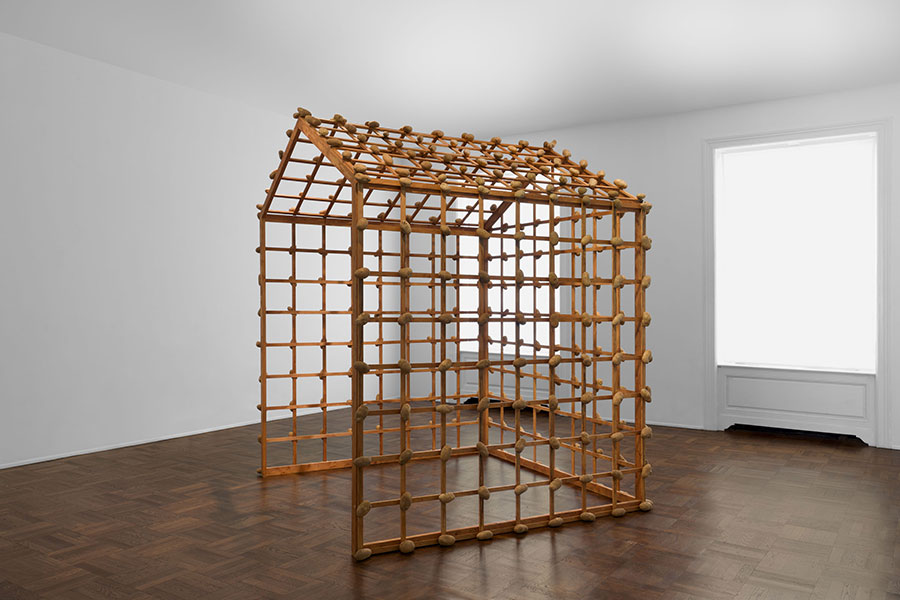Sigmar Polke’s Unrealized Utopia at Michael Werner Gallery
These unusual and little-known early works from the 1960s revel in flawed functionality
These unusual and little-known early works from the 1960s revel in flawed functionality

‘Some day we shall no longer need pictures. We shall just be happy.’ These confident sentences, attributed to German artists Gerhard Richter and Sigmar Polke, date from the late 1960s – a period currently under review in ‘Sigmar Polke: Objects: Real and Imagined’ at Michael Werner Gallery, London. Light-heartedly imagining a period after art, or when all our lives have become art, is pure Polke. But here, any suggestion of such a visionary attitude is held at bay. We are given very little in the way of Polke’s acerbic ‘capitalist realist’ works that operated across media and so cleverly balanced the contradictions of West German consumer culture. Instead, this selection of schematic drawings – less so the eccentric sculptures – are flattened by the banality of their display. Isolated in immaculately hung frames, they feel aware of their inconsequentiality. You can almost sense Polke smirking in these blueprints for a near-future, which gesture towards utopia while obstinately lacking any ambition to get there.

The artist’s early drawings mainly concern social and economic life in the Federal Republic of Germany between 1963 and 1970 – a place and a time that, despite the country’s buoyant economy and recent purchasing power, was not altogether happy for many struggling Germans, including Polke himself. Then an art student at the Kunstakademie Düsselfdorf, he was making ends meet doing menial work in a finance office and selling stained-glass windows whilst living with his wife and two children in a tiny flat. A series of carnivalesque, rudimentary drawings appear as blueprints for transient dwelling-places of tomorrow. In one drawing, Cage Made from Coloured Slats (c.1969), Polke imagines a matrix of bright lines in squares; in another, Sculpture, Wooden Framework with Clothespins, Random Items Can Be Attached to the Clothespins (1968), the artist indicates his interest in the aleatory and perhaps transformational properties of mass-produced domestic items. They feel like the fantasies of a mid-century, mid-level furniture designer with a characteristic German wit that revels in flawed functionality.

The materials Polke proposes for rebuilding the fabric of the country are polymorphous: paper sheets, plaster arches, potatoes. Resembling a latticed shed on a petit-bourgeois allotment, the sculpture Object Potato House (1967/90) transforms the humble tuber into an organizing principle for the functional architectures that are built to produce it. Placing the spontaneous flowering of natural vegetation against a rigid grid structure, Polke asks us to interrogate the relationship between what we produce and what we consume without the earnestness that characterized much anti-capitalist discourse of the late 1960s.
Perhaps the most compelling drawings are Polke’s bird’s-eye-views of diagrammatic spirals. In Expanding the Planetary System with a 10th Planet (1968), the artist identifies himself as an extra planet called Polke – a dot beyond Pluto, the furthest outlier from the central energy of the sun. With his planet scaled up to emphasize its significance as the most extreme orbiting structure in the solar system, Polke ironizes the often-hyperbolized status of the artist as a planetary force. The same direction of travel, moving from a centre to its periphery, directs another drawing, This Stain Appeared much later on the Paper. But It Has Lent the [Un]intended Effect to the Drawing (c.1967–68), in which, as narrated in barely legible scribbles, an accidental mark has left an impression on the original work. Polke manages to persuade us that it is neither the artist who creates meaning nor the systems he employs. If meaning, hope, future might turn up through the back door, so to speak, then so be it – but he was never going to take us there.

‘Perhaps everything will come together sometimes I can’t say,’ mused a more ambivalent Polke to Dieter Hülsmanns, in an interview with the Rheinische Post in 1966, describing his multifarious approach to making art. ‘I’m very happy about this sort of many-sidedness.’ On the basis of this exhibition, I’m afraid to say, I don’t feel quite as content. We still haven’t arrived at the someday that Polke and Richter envisioned in 1966. But Polke always knew that.
























